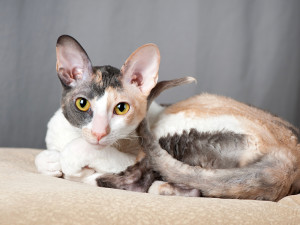Do Cats Always Land on Their Feet? The Science Behind the Cat Flip
The science behind the feline ability to land on their feet

Share Article
If you’ve ever heard the saying “cats always land on their feet”, or seen your feline friend fall off the table and marvelled at the fact they landed much more gracefully than you would have, then you’re already aware of the ‘righting reflex’ – even if you didn’t know the name for it. Put simply, the righting reflex refers to the ability of cats to right themselves during a fall. But what special kitty superpowers are they using to do this? We spoke to an expert to find out.
What is the cat’s righting reflex and when does it develop in kittens?
“The cat’s righting reflex is an innate and amazing ability that allows cats to reorient their bodies in mid-air and land on their feet after a fall,” explains Georgina Harris, European specialist in veterinary neurology and neurosurgery at the University of Cambridge. This skill starts developing when kittens are just a few weeks old, and by 6–9 weeks, they’ve usually mastered it, she says.
This reflex is essential for their survival in the wild, as it protects them from injuries caused by falls. Even domesticated cats with their cushy indoor lives still possess this instinctive skill.
How does the righting reflex work?
“The righting reflex relies on a combination of anatomy, physics and feline agility,” says Georgina. But can ultimately be broken down into a few key traits present in all cats.
Inner ear balance
“Cats have a highly sensitive vestibular apparatus – a system of sensors and a control centre that helps maintain balance and orientation – in their inner ear that helps them detect their orientation in space,” says Georgina. This system allows them to sense which way is up and adjust their bodies accordingly. In contrast, cats with vestibular disordersopens in new tab may have difficulty maintaining their balance.
Flexible spine
You’ve probably seen your cat contort themselves into the shape of a pretzel to fit into a tiny space or cardboard box, and this is all thanks to their flexible spin. “Cats have incredibly flexible backbonesopens in new tab, with more vertebrae than most mammals in their thoracic and lumbar regions, which gives them greater flexibility and mobility,” says Georgina. For comparison, cats have 13 thoracic vertebrae, while humans have 12; and they have seven lumbar vertebrae, while humans have five. “This flexibility allows them to quickly twist their bodies with precision and land on their feet,” says Georgina.
Segmented movement
If you watch a slow-motion video of a cat falling (not something we recommend you intentionally try at home), you’ll notice that cats rotate their head first to align with the ground. “Then, using their front legs, they twist the upper body, followed by the lower body,” says Georgina. This segmented motion allows them to achieve the correct landing position.
Tail as a counterbalance
Cats’ tails have a lot of uses, including balance, sense and communication, and “while not always necessary, a cat’s tail can act as a counterweight to fine-tune their orientation”, explains Georgina. For example, when a cat swerves to the right their tail will swing to the left; and when a cat jumps upwards their tail will go down. “In fact, the length of a cat’s tail is proportionate to their overall body size precisely so that they can adequately manage their balancing needs.”
Legs absorb impact
“Once oriented, cats spread their legs to increase surface area and slow their descent, then bend their joints upon landing to absorb the impact,” says Georgina. Clever stuff, right?
What are the evolutionary advantages of the righting reflex?
The righting reflex likely evolved as a survival mechanism. Cats are natural climbers, often scaling trees or high structures in search of prey or safety. Falling from a height is a common risk, and the ability to land on their feet increases their chances of survival. “This skill also protects vital organs by distributing the force of impact,” says Georgina.
Although our domesticated cats mostly live in luxury with little danger, even in an environment without predators or prey, cats frequently explore high perches such as shelves or window sills, where falls are possible. In fact, Georgina encourages cat parents to install perches and ledges for their cats to climb around the house so they can fulfil this natural instinct for climbing.
What are the limitations of the righting reflex?
While the righting reflex is impressive, it’s not foolproof. Here are some of its limitations:
Short falls: “If a cat falls from a very low height (less than 1–2 feet), there may not be enough time to fully engage the reflex, leading to injury,” explains Georgina.
Extreme heights: although cats can survive falls from great heights, injuries are more likely as the distance increases.
Age and health: “Older cats or those with mobility issuesopens in new tab may not execute the reflex as efficiently, increasing their risk of injury,” says Georgina, who advises cat parents with senior felines remove the opportunity to climb too high in the home or roam too far outside.
Obstacles during a fall: if a falling cat hits an object on the way down, it can disrupt their ability to reorient, making a safe landing less likely.
How high can a cat safely fall?
Cats can survive falls from surprising heights, sometimes even greater than seven stories, due to their ability to slow their descent. “However, the term ‘safely’ is misleading,” explains Georgina. “Even though a cat might survive a fall from a high balcony or window, injuries are still possible or even likely.”
Interestingly, studies have shownopens in new tab that falls from higher than two stories sometimes result in fewer injuries than shorter falls. “This is because cats have more time to fully engage their reflex and reach a terminal velocity, allowing them to spread their bodies and reduce the impact force,” says Georgina.
Despite this, no height should be considered ‘safe’ for a falling cat.
Tips for keeping cats safe from falls
While we can’t wrap our cats in cotton wool and protect them from all the dangers of the world, as much as we’d like to, there are a few ways you can lessen the risk of feline falls.
Secure windows and balconies: many cat parents live in flats higher than the ground floor, which means it’s important to install screens or cat-proof barriers on windows and balconies to prevent accidental falls.
Provide safe climbing options: offer indoor climbing trees, shelves or perches to satisfy their climbing instincts without exposing them to danger.
Supervise outdoor access: if your cat ventures outside, you may wish to keep an eye on them to ensure they’re not climbing up anything too high and unstable – and to be on hand to shake a bag of Dreamies at them if they do start venturing skywards.
Keep an eye on senior cats or those with health conditions: “Ageing cats might struggle with balance or agility, increasing their fall risk,” cautions Georgina.
Common myths about cats and falling
There are several myths surrounding cats and their ability to land on their feet.
Cats always survive falls
“While cats often survive falls from moderate heights, they are not invincible. Severe injuries, including fractures and internal damage, can and do occur,” says Georgina.
Cats don’t get hurt when they land
“Cats may minimise injury thanks to their reflex and physiology, but they can still suffer from broken bones or sprains.”
Cats can jump from any height without consequences
The height of a fall plays a significant role in whether a cat lands safely or gets injured – they may have ‘nine lives’ but they’re not invincible!
The cat’s righting reflex is an incredible example of evolutionary skill, blending instinct, anatomy and physics. While this ability protects them in many situations (and looks very impressive) it’s not a guarantee of safety. As pet parents, understanding the reflex and its limitations can help us create a safer environment and a longer life for our feline companions – which is, of course, the ultimate goal.
Resources

Ro Elfberg
Ro previously served as Kinship’s Senior Editor. Now a freelancer, she has written and copy-edited for British Vogue, Glamour, DICE and of course, Kinship. When she’s not being manipulated into dishing out Dreamies to Kobe the cat, she spends her free time trying to convince her snake, Butters, to wear a tiny hat.
Related articles
![Home cat sitting on a chair with citrus.]()
Everything You Need to Know About Your Cat’s Incredibly Powerful Nose
They have up to 200 million odour receptors that can pick up all the good (and horrible) smells. Learn how to best support their sensitive sniffers
![a cat making an excited face at a person's hand]()
Your Cat Can Make Nearly 300 Unique Facial Expressions, Study Finds
They’re not so mysterious after all
![Cornish Rex cat laying down on a pillow]()
The Cat Breed-Behaviour Connection
Which cats are more likely to have stranger danger? Bite the hand that feeds them? Get the zoomies? Scientists studied 5,700 pet cats and discovered some interesting traits
![Cheerful Black Woman Caressing Cats On Couch]()
30 Strange Signs My Cat Is Happy
From puking on your least favourite shoes to biting you less (not zero, just less), here are all the ways to tell if your cat is actually happy
![Young woman hugging her cat]()
Why Do Cats Purr?
Surprise: it doesn’t always mean they’re happy
![Two cats walking with their tails sticking straight up]()
Tail Talk: What Is Your Cat Trying to Tell You?
Cats are enigmas. But their tail movements can reveal a lot about their moods










